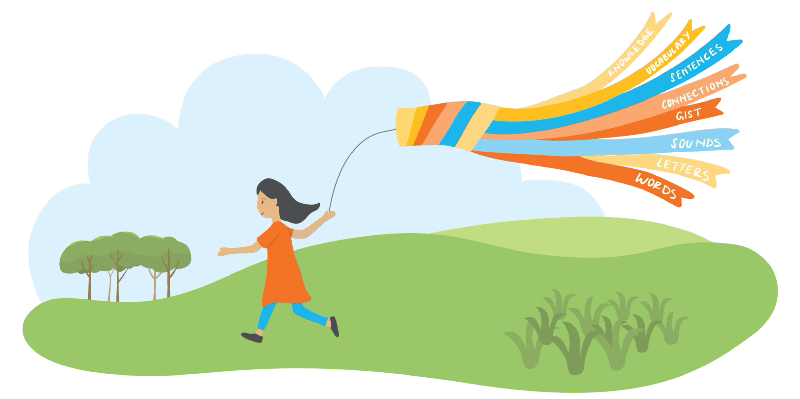
The first of five: Phonemic and phonological awareness
Phonemic awareness and phonological awareness—together, they’re the first of the five foundational reading skills articulated by the Science of Reading.
The two are intertwined, but not interchangeable. Even though they combine to form one skill, they have distinct meanings and play different roles in helping children become proficient readers.
In the first of this five-part series on foundational skills, we’ll look at where the path to literacy begins—and why it all starts with sounds.
What the Science of Reading tells us about the brain
First, an essential reminder: Our brains are not hard-wired for reading. They do not intrinsically know that marks on a page are designed to represent sounds, or meaning. That’s why reading must be taught, explicitly and systematically.
But when we teach reading using what science tells us, the brain wires itself to start recognizing those letters, syllables, and words.
“Reading comes through building new neural pathways,” says Alice Wiggins, vice president of instructional design and products at UnboundEd and our guest on Season 3, Episode 2 of Science of Reading: The Podcast. “That’s what happens,” she says, “when we’re taught to read.”
Why it starts with sound
The Simple View of Reading establishes that if you can’t decode the symbols (letters and combinations of letters) that make up a sentence, you can’t read it—even if you know the language in which it’s written.
And when it comes to spoken language, those symbols were created to capture sounds.
“Teaching kids that letters represent the sounds in speech has the most potent logic, because written language was invented to represent speech,” says Dr. Louisa Moats, an expert on how children learn to read and our guest on Season 3, Episode 3 of Science of Reading: The Podcast. “We don’t learn to talk from reading. We already know how to talk. We have to learn this system that is mapped onto speech.”
Phonemic awareness and phonological awareness form the building blocks for understanding the relationship between sounds and letters, paving the way for successful reading acquisition.
To understand how important they are, look no further than the Reading Rope, a visual representation of the key skills involved in reading. The strands of the rope represent various interconnected components, including phonological awareness, phonics, vocabulary, fluency, and comprehension.
Phonological awareness and phonemic awareness are positioned as the foundational strands.
To understand why, we’ll need to get more specific.
What is phonemic awareness?
Phonemes are the smallest units of sound that make up words. Phonemic awareness refers to the ability to identify and manipulate individual sounds (phonemes) in spoken words.
Phonemic awareness plays a vital role in the early stages of reading. By recognizing and manipulating individual sounds within spoken words, kids come to understand how sounds combine to form words.
This ability to segment and blend sounds lays the foundation for phonics, and the ability to decode and read unfamiliar words.
What is phonological awareness?
Phonological awareness encompasses a range of skills that go beyond manipulating individual phonemes. It includes abilities such as recognizing and manipulating larger units of sound, such as syllables, rhymes, onset and rime, and even entire words. It involves tasks like clapping out the syllables in a word, identifying words that rhyme, recognizing words with the same initial sound, and blending or segmenting words into syllables.
This awareness of larger sound units enhances readers’ ability to identify and manipulate individual phonemes. That, in turn, sets the stage for word recognition and decoding.
Phonology and equity
Alice Wiggins notes that just as reading skills start with sound, so does equity. It’s important to acknowledge that students speak and are exposed to a wide variety of pronunciations of English letters and words.
“Being explicit and systematic attends to those differences for all students,” she says.
More ways to learn
- Subscribe to Science of Reading the Podcast for the latest insights from researchers and practitioners in early reading.
- Explore our Science of Reading toolkit for dual language learners.



